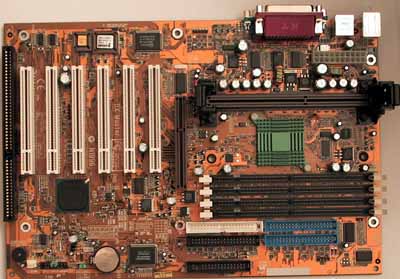Intel 440BX 133MHz Motherboard Roundup (June 2000)
by Anand Lal Shimpi on June 2, 2000 2:06 AM EST- Posted in
- Motherboards
Microstar BXMaster - Click Here for the AnandTech Review
|
Motherboard Specifications |
|
| CPU Interface |
Slot-1
|
| Chipset |
Intel
440BX
Promise 20262 UDMA 66 Controller |
| L2 Cache |
N/A
(on-chip)
|
| Form Factor |
ATX
|
| Bus Speeds |
66
/ 75 / 78 / 81 / 83 / 90 / 95
100 / 105 / 110 / 112 / 115 / 117 / 120 / 122 / 124 126 / 133 / 135 / 138 / 140 / 142 / 144 / 150 / 155 |
| Voltages Supported |
Auto
Detect
Adjustable to 1.3V - 3.5V |
| Memory Slots |
4
168-pin DIMM Slots
|
| Expansion Slots |
0
AMR Slots
1 AGP Slot 6 PCI Slots (5 Full Length) 1 ISA Slot (1 shared / 1 full length) |
| BIOS |
Award
4.51PG
|
The Microstar BXMaster is also a holder of the AnandTech Editor's Choice award because of its incredible balance of features and performance.
Unlike other boards with 6 PCI slots, the BXMaster features a PCI arbiter chip that allows all 6 slots to support bus master devices. This means that all six slots are usable by any PCI devices.
The BXMaster also features the Promise 20262 controller that is also found on the Gigabyte GA-6BX7+. This provides the board with the two Ultra DMA 66 channels that it features in addition to the Ultra DMA 33 channels provided by the Intel PIIX4e South Bridge. As we mentioned before, we have generally found the Promise controller to have fewer compatibility problems than the High Point controller that is found on the ABIT and Soyo boards.
It should be noted that the Gigabyte board detects drives much faster than the Microstar BXMaster in spite of the fact that both boards use the same Promise controller.
The IRQ sharing scheme on the BXMaster is identical to that of the GA-6BX7+. The AGP slot can share an IRQ with either the first or the second PCI slots, the third and sixth PCI slots share an IRQ as do the fourth and fifth which also share an IRQ with the on-board USB controller. The on-board Promise controller shares an IRQ with the fourth slot.
The BXMaster still uses the Award 4.51PG BIOS but it features MSI's CPU Plug & Play III Jumperless CPU Configuration Utility. FSB options include 66 / 75 / 78 / 81 / 83 / 90 / 95 / 100 / 105 / 110 / 112 / 115 / 117 / 120 / 122 / 124 / 126 / 133 / 135 / 138 / 140 / 142 / 144 / 150 / 155, which puts it ahead of virtually everything on the market, surpassed primarily by the ABIT BF6 and BE6-II with their SoftMenu III support. The PCI speed is reported next to the FSB setting, which should help you keep things as close to the 33 MHz PCI spec as possible. PCI ratios of 1:4, 1:3, and 1:2 are automatically set based on FSB speed
Vcore settings range from 1.30 - 2.10V, in 0.05V increments and then from 2.1V to 3.5V in 0.1V steps. Only a limited range of voltages is displayed based on the CPU used - for example, our testbed Pentium III 550E had a default voltage of 1.6V and could be set to anything between 1.30V and 2.00V. An additional feature the MSI has implemented is support for chipset voltage, which ranges from 3.3V to 3.6V in 0.1V steps.











0 Comments
View All Comments